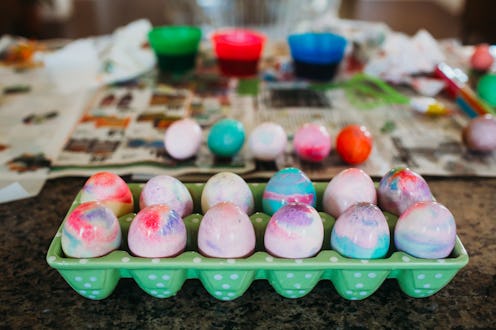
Year after year, I was disappointed that my Easter eggs never looked the way they did on my box of PAAS — as pretty much the leader in Easter Egg dye kits, PAAS always seemed to be the standard household brand. If you're trying to figure out how to make Easter eggs when you don't have a box filled with dye and stickers, believe me — there is an easy way. Even if you don't have kids, it's always fun to dye (and eat) a bunch of eggs for the holiday. In fact, if you're in a new relationship, this activity can be a low-cost way to have fun, and get creative. Even if you're the type of person who doesn't do much on the holiday itself, besides buy discounted candy the next day, the process of egg-dyeing might just take you back to childhood. Can I guarantee that your eggs will be PAAS-worthy? Well, no. But I can guarantee that you'll be like, "this was so easy that I can't believe that I didn't just use the materials I had at home the entire time." (I'm guessing you have food coloring at home.)
The materials you'll need are pretty straightforward: A bunch of coffee cups, number depending on how many colors you want, food coloring, vinegar, vegetable oil, some newspaper to help catch any spills, and a spoon. If you're looking to make multicolored eggs, you might want to fashion a fancy PAAS-style egg dipper out of some paperclips — enough to create a round base to hold the egg, and a handle.
1. Boil your eggs
Since dyeing eggs that aren't boiled would end in a hilarious disaster, make sure you have plenty of hard boiled eggs handy. To properly hard boil an egg, you'll want to put them in a saucepan and cover them with one to two inches of cold water. Multiple eggs require a lot more water, so it's better to be generous with the water, rather than risk it. Adding a little bit of salt to the water will later help in peeling the eggs, post-holiday. Heat the pot on high until you see a generous boil. From there, cut the heat, cover the saucepan, and let them sit for about 10 to 11 minutes.
If you're cooking the eggs for use at a later day, cool them under some cold water and pop them in the fridge. If you're planning on dyeing them immediately, put them in a large mixing bowl with icy cold water, and let them sit until they've cooled.
2. Arrange your table
Put some newspaper out (unless it's an old table you're itching to find an excuse to replace), and place your coffee cups in the center. Each cup should include about a half cup of hot, or even boiling, water, and one tablespoon of vinegar. From there, you'll want to add about 20 drops of dye to each mug.
If you're totally out of food coloring, and have a lot of patience, there are a few beverages that'll give some coloration to your eggs as well. For example, some vinegar and a strong cup of coffee, plus a night in the fridge to soak, will give you a subdued light brown egg, and grape juice and vinegar, with the same overnight step, will give you a lavender egg. It's fun, and strange, but unless you want to cram your fridge full of weird egg-filled concoctions, I'd stick to the food coloring method.
3. Start dyeing
Carefully drop each cooled egg into the color cup of your choosing. There's no exact way to tell when each egg will be properly colored — that's up to you, and your own preference (but in general, it's three minutes). For me, yellow always seemed to come out the brightest and quickest. For a half-and-half colored egg, dip your egg partially in the dye with your spoon, and wait until you're satisfied, flipping it around with the second color when you're ready. When you're creating Easter eggs, creativity is key. Don't be too bent out of shape if your masterpiece turns brown, as many of them do. I'm sure that even Banksy has created a bad egg or two.
Also, consider using stickers. If you have heart stickers left over from Valentine's Day, or all-occasion star stickers, you can stick those on the eggs before dropping them in the dye, peeling them off when the egg is completely dry, for a neat design. You can also try adding some extra color by dropping food coloring directly on the egg after it's been dipped, and moving the color by blowing on it through a straw.
4. Dry your eggs
The best ways to dry an egg are to place it back in its carton, or use a wire rack. Paper towels might wipe off some of the dye on the part of the egg that's laying on them, but they're also good in a pinch. Be patient — you don't want to accidentally ruin your egg masterpieces by handling them before they're fully set.
5. Polish your eggs
If you want to give your eggs a bit of shine, use the tiniest amount of vegetable oil. It's just an added extra to make your eggs look the best they can be.
Eggs should, of course, be stored in the fridge, and eaten whenever you feel the need for a protein boost on Easter. You might feel bad chomping on your artwork (especially if you decided to decorate them with faces) but hey — at the end of the day, it's an egg. It's meant to be enjoyed.
For more ideas, check out Bustle on YouTube.
Images: Cavan Images/Cavan/Getty Images; Giphy (5)